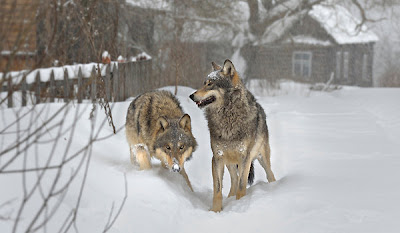October 20, 2011
Radioactive Wolves on PBS's NATURE
Whenever there's nothing to watch on TV, you can always count on something interesting on PBS. Last night, I randomly clicked over to WNET-13 and found a fascinating show about how packs of wolves have not only survived but thrived in the radioactive no-man's land surrounding the Chernobyl nuclear power plant. The explosion at the Soviet-run reactor in 1986 remains the worst nuclear accident, bypassing even the near meltdown in Japan earlier this year. The disaster created a zone of intense radiation around the plant that also emptied nearby company-town Pripyat, turning it into a creepy industrial ghost town.
Though humans cannot live in this disaster areas, wild animals strangely enough do and have actually thrived there. The documentary, presented as part of the NATURE series, is not only about the wolves but also about how herds of bison and wild horses (extinct in this part of Europe since the 1880s) now roam this desolate landscape. The area has become something of a sanctuary for endangered species. One of the oddest facts is the super-size catfish living in a former reactor cooling pond that are now more than 8 feet long. They aren't that size though due to radioactivity. It's because they just kept growing after 1986 when their immediate natural predators were killed off the by initial accident. Catfish can live up to 100 years old, if not eaten by other animals. So these fish as enjoying an unusually fat, chill, relaxed life in the shadow of a nuclear disaster.
The doc was filled with all sorts of bizarre facts like this, told in the typically dry and slow-pace that PBS still favors. In fact, I'd go so far to say PBS is a sanctuary of sorts compared to the insane pacing and utter lack of information on most commercial television. So if you're looking for something unusual and informative, it will surely repeat again or you can watch some cool clips on the PBS website.
Subscribe to:
Posts (Atom)
